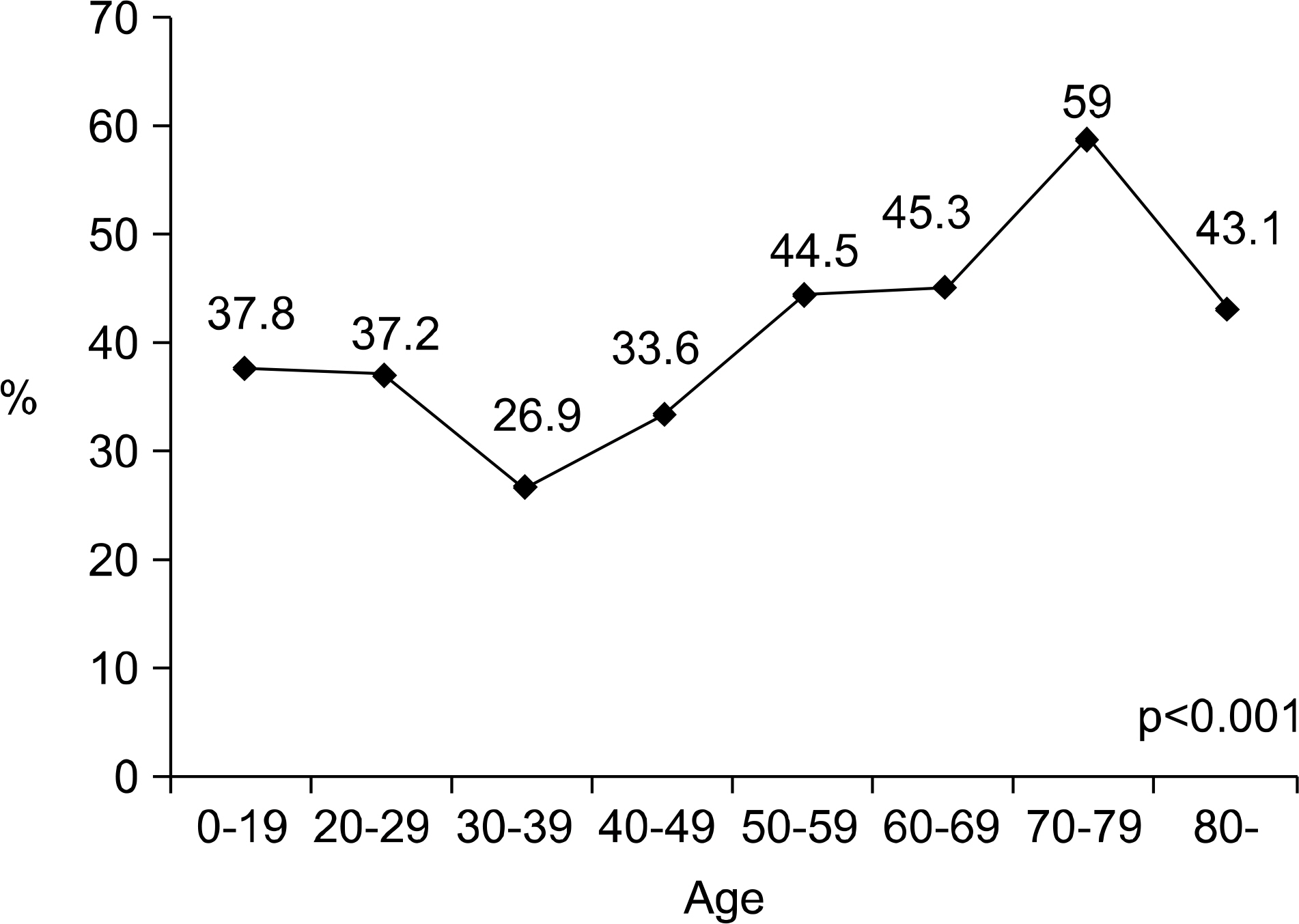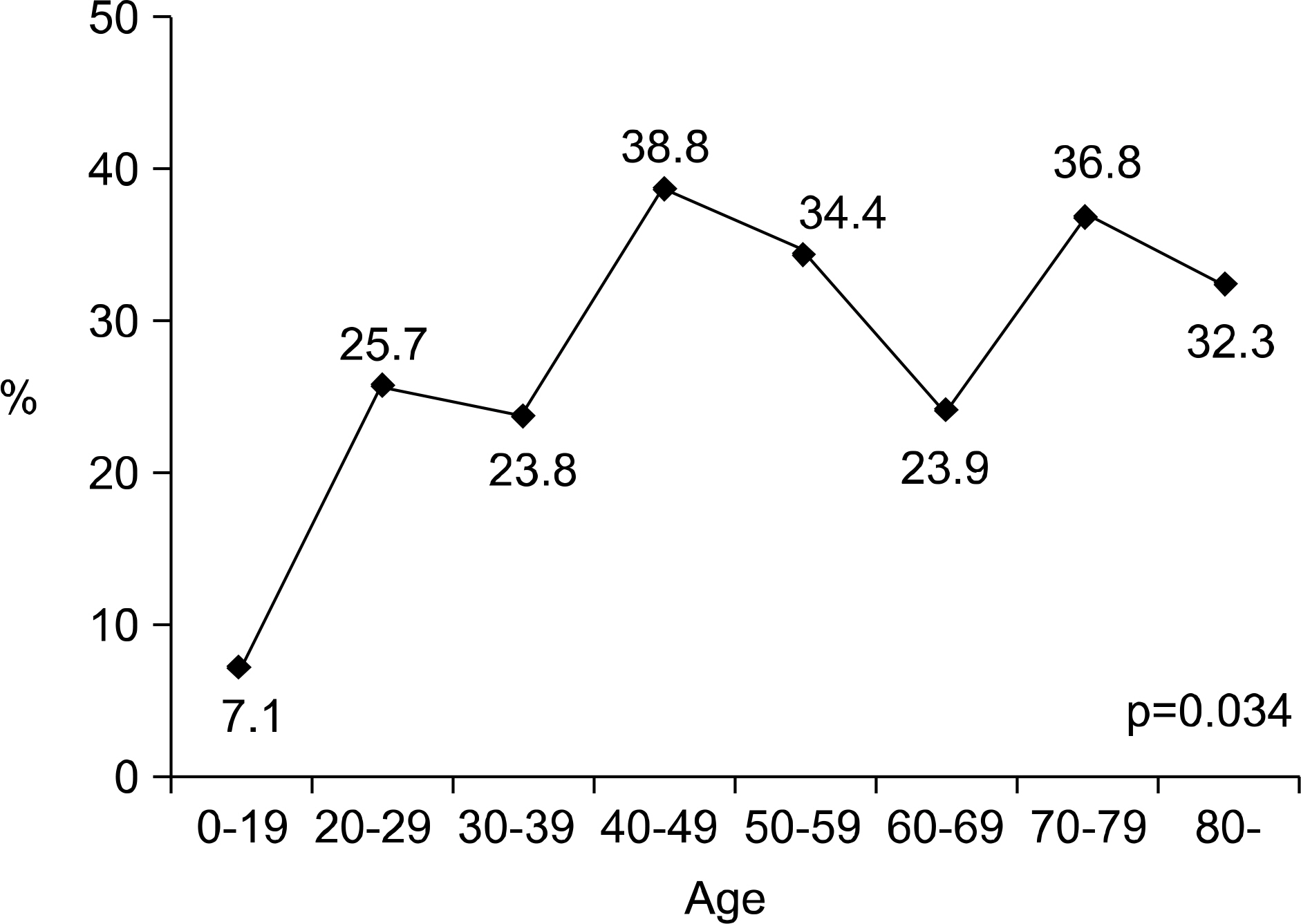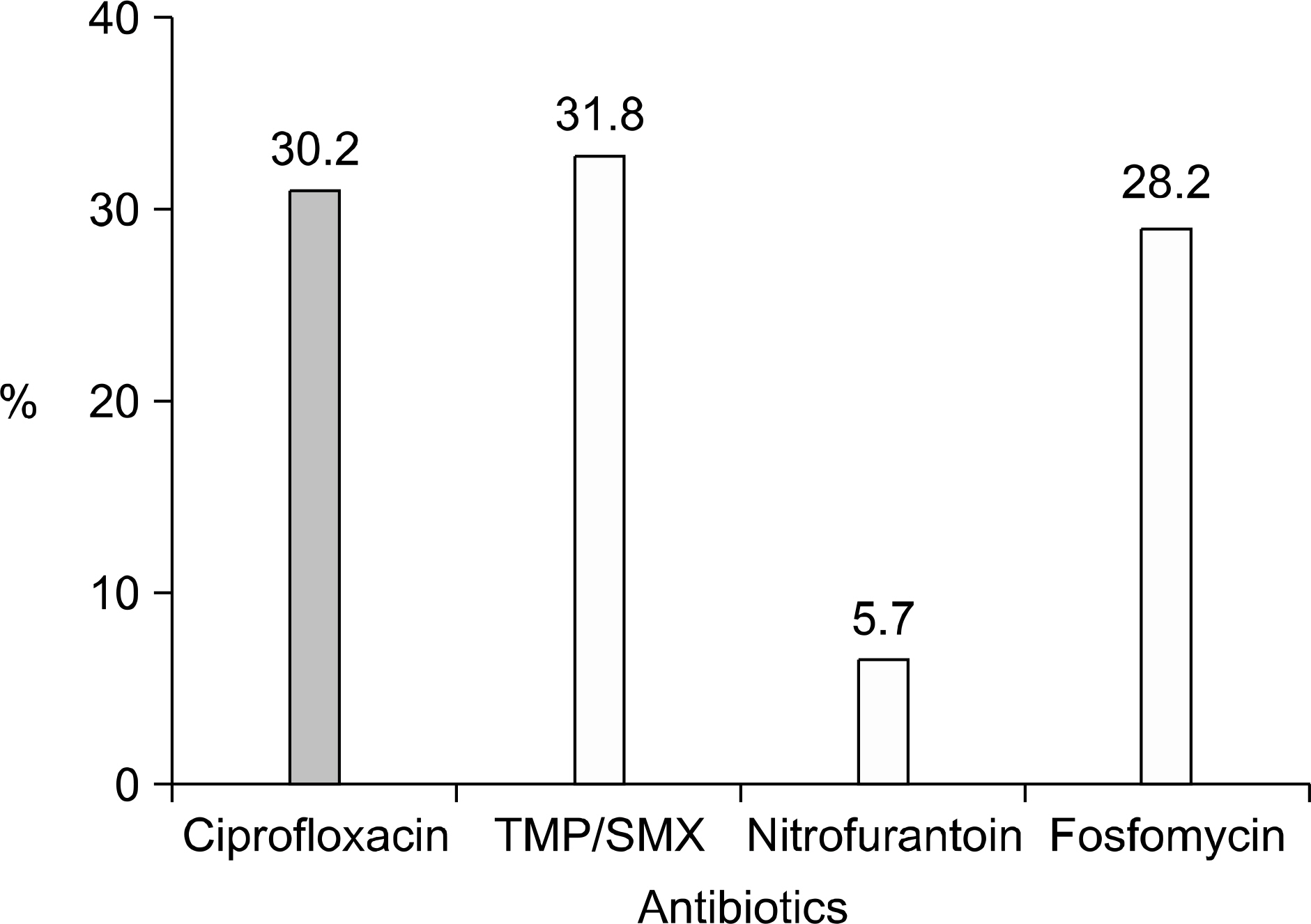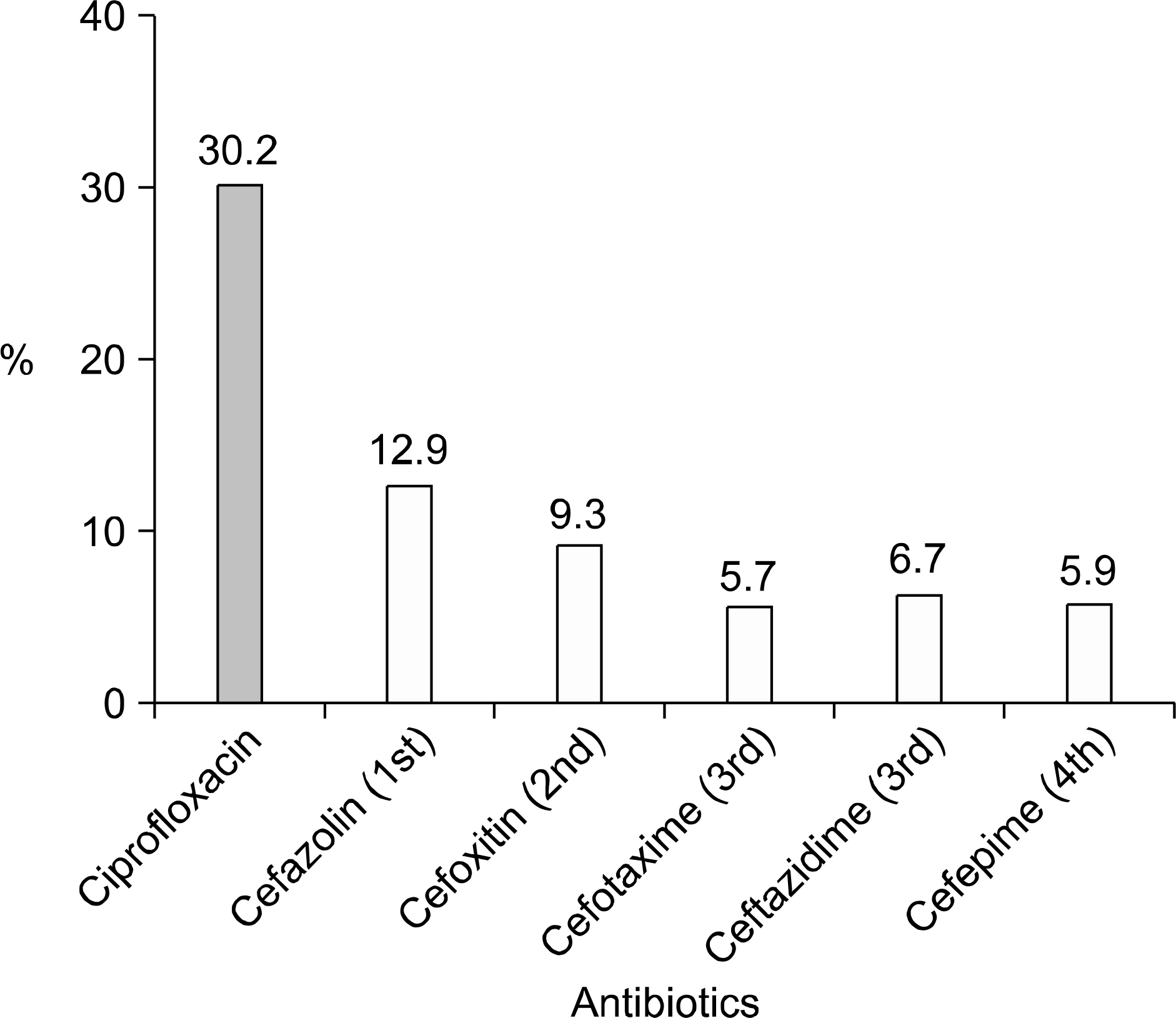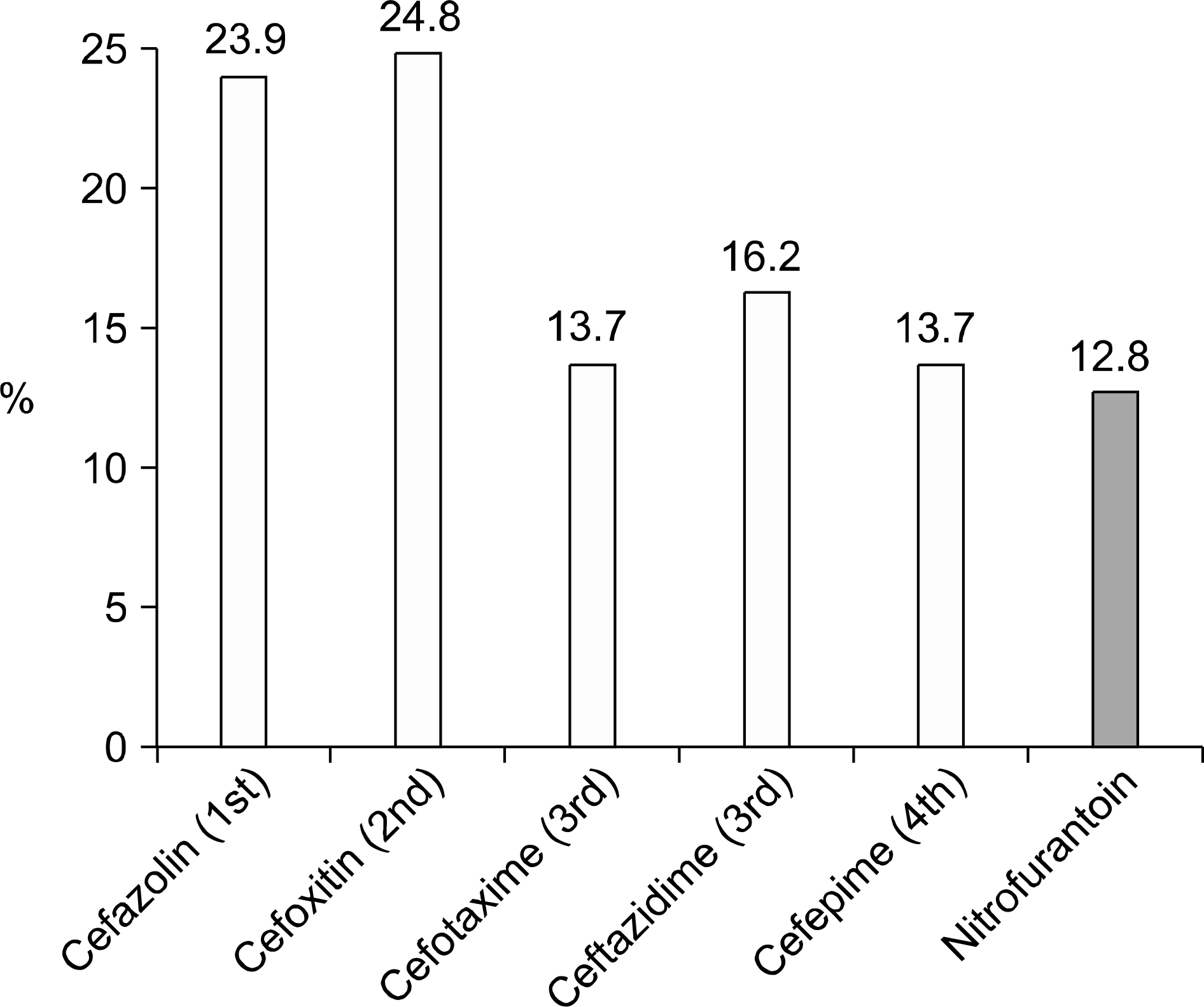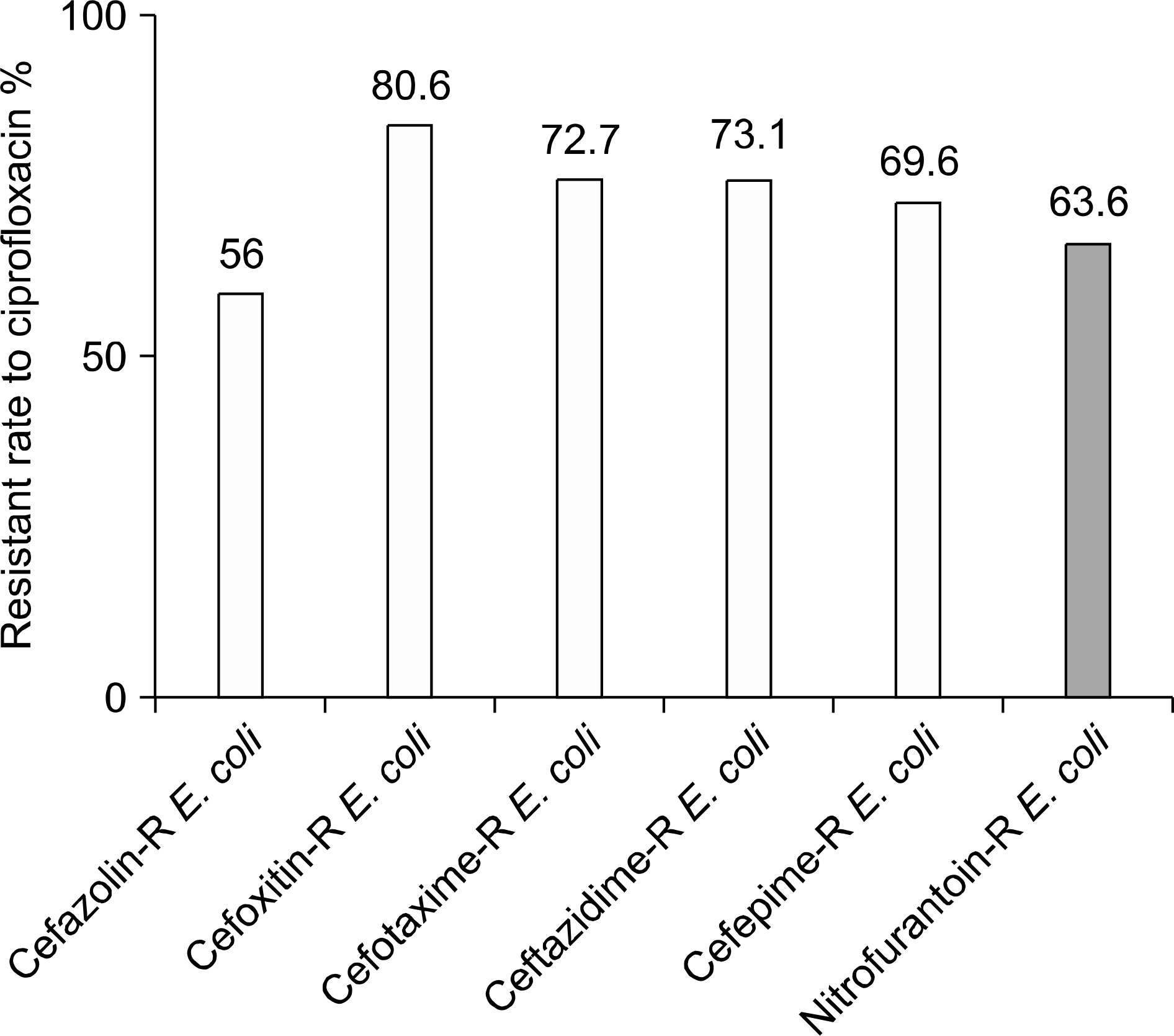Korean J Urol.
2008 Jun;49(6):540-548.
The Ciprofloxacin Resistance Pattern of Escherichia coli Isolated from Female Patients with Community- acquired Urinary Tract Infection in the Jeonnam and Gwangju Region for the Recent 2-years
- Affiliations
-
- 1Department of Urology, College of Medicine, Chosun University, Gwangju, Korea. dhlim@chosun.ac.kr
Abstract
-
PURPOSE: The overuse of ciprofloxacin has recently increased the resistance of the Escherichia coli(E. coli). We studied the prevalence od the ciprofloxacin-resistant(CR) E. coli that were isolated from female patients with community-acquired urinary tract infection(CAUTI), and we demonstrated the resistant rate to other antibiotics to help physicians choose the suitable antibiotics to properly treat CAUTI.
MATERIALS AND METHODS
From January 2006 to December 2007, we retrospectively analyzed 910 female patients with CAUTI. Among them, we chose 387 patients infected by E. coli and we evaluated the resistance rate to ciprofloxacin and its relationship with age, the disease causing the UTI and the previous antibiotics. We also compared the resistance to ciprofloxacin with that of other antibiotics, including cephalosporin and the other antibiotics recommended by the guidelines of the Infectious Diseases Society of America(IDSA).
RESULTS
The incidence of UTI by E. coli increased with age(p<0.001), and it was highest in the 7th decade (59.0%). One hundred seventeen (30.2%) patients showed ciprofloxacin resistance. It was significantly related to an increased age(p=0.034), complicated UTI(p=0.04) and a previous history of antibiotic use(p=0.023). Trimethoprim/sulfamethoxazole(TMP/SMX) and fosfomycin showed similar resistance rates like ciprofloxacin; 31.8 and 28.2%, respectively. On the other hand, nitrofurantoin showed a low resistant rate of 5.7%. The resistance to cephalosporin was low in general; the lowest was cefepime(5.9%).
CONCLUSIONS
Our results imply that the empirical use of ciprofloxacin for female patients with CAUTI is questionable, and especially for patients older than 40 years old, patients with complicated UTI and patients with a previous history of antibiotic use. Nitrofurantoin and cephalosporin can be useful agents for the treatment of female CAUTI.
Keyword
MeSH Terms
-
Anti-Bacterial Agents
Ciprofloxacin
Communicable Diseases
Community-Acquired Infections
Drug Resistance, Bacterial
Escherichia
Escherichia coli
Female
Fosfomycin
Hand
Humans
Incidence
Nitrofurantoin
Prevalence
Retrospective Studies
Urinary Tract
Urinary Tract Infections
Anti-Bacterial Agents
Ciprofloxacin
Fosfomycin
Nitrofurantoin
Figure
Reference
-
1. Warren JW, Abrutyn E, Hebel JR, Johnson JR, Schaeffer AJ, Stamm WE. Guidelines for antimicrobial treatment of uncomplicated acute bacterial cystitis and acute pyelonephritis in women. Infectious Diseases Society of America (IDSA). Clin Infect Dis. 1999; 29:745–58.2. Foxman B. Epidemiology of urinary tract infections: incidence, morbidity, and economic costs. Am J Med. 2002; 113(Suppl 1A):S5–13.
Article3. Kunin CM. An overview of urinary tract infection. Definition, prevention and management. 5th ed.Baltimore: Williams & Wilkins;1998. p. 2–21.4. Engel JD, Schaeffer AJ. Evaluation of and antimicrobial therapy for recurrent urinary tract infections in women. Urol Clin North Am. 1998; 25:685–701.
Article5. Stamm WE, Norrby SR. Urinary tract infections: disease panorama and challenges. J Infect Dis. 2001; 183(Suppl 1):S1–4.
Article6. Nicolle LE. Epidemiology of urinary infection. Infect Med. 2001; 18:153–62.7. Song HJ, Kim SJ. A study of antimicrobial sensivity to the causative organism of urinary tract infection. Korean J Urol. 2005; 46:68–73.8. Ryu KH, Kim MK, Jeong YB. A recent study on the antimicrobial sensitivity of the organisms that cause urinary tract infection. Korean J Urol. 2007; 48:638–45.
Article9. Ti TY, Kumarasinghe G, Taylor MB, Tan SL, Ee A, Chua C, et al. What is true community-acquired urinary tract infection? Comparison of pathogens identified in urine from routine outpatient specimens and from community clinics in a prospective study. Eur J Clin Microbiol Infect Dis. 2003; 22:242–5.
Article10. Chang IH, Bang SH, Choi NY, Park SY, Han JH, Ahn SH. Trends in the emergence of ciprofloxacin-resistant escherichia coli and the relationship with underlying diseases in patients with urinary tract infection. Korean J Urol. 2008; 49:66–71.
Article11. Lee SJ, Cho YH, Kim BW, Lee JG, Jung SI, Lee SD, et al. A multicenter study of antimicrobial susceptibility of uro-pathogens causing acute uncomplicated cystitis in woman. Korean J Urol. 2003; 44:697–701.12. Ko YH, Oh JS, Cho DY, Bea JH, Koh SK. Changes of causative organisms and antimicrobial sensitivity of urinary tract infection between 1979 and 2001. Korean J Urol. 2003; 44:342–50.13. Karlowsky JA, Kelly LJ, Thornsberry C, Jones ME, Sahm DF. Trends in antimicrobial resistance among urinary tract infection isolates of Escherichia coli from female outpatient in the United States. Antimicrob Agents Chemother. 2002; 46:2540–5.14. Tice AD. Short-course therapy of acute cystitis: a brief review of therapeutic strategies. J Antimicrob Chemother. 1999; 43(Suppl A):85–93.15. Karaca Y, Coplu N, Gozalan A, Oncul O, Citil BE, Esen B. Co-trimoxazole and quinolone resistance in Escherichia coli isolated from urinary tract infections over the last 10 years. Int J Antimicrob Agents. 2005; 26:75–7.
Article16. Gobernado M, Valdes L, Alos JI, Garcia-Rey C, Dal-Re R, Garcia-de-Lomas J, et al. Quinolone resistance in female outpatient urinary tract isolates of Escherichia coli: age-related differences. Rev Esp Quimioter. 2007; 20:206–10.17. Hames L, Rice CE. Antimicrobial resistance of urinary tract isolates in acute uncomplicated cystitis among college-aged women: choosing a first-line therapy. J Am Coll Health. 2007; 56:153–6.
Article18. Wright SW, Wrenn KD, Haynes ML. Trimethoprim-sulfamethoxazole resistance among urinary coliform isolates. J Gen Intern Med. 1999; 14:606–9.
Article19. Neuman M, Fluteau G. Treatment of urinary infections with fosfomycin. Chemotherapy. 1977; 23(Suppl 1):259–64.
Article20. Lee SE, Choi H, Kim YK. A clinical study of oral fosfomycin (FosmyinⓇ) in the treatment of lower urinary tract infection. Korean J Urol. 1984; 25:167–72.21. Lobel B, Valot A, Cattoir V, Lemenand O, Gaillot O. Comparison of antimicrobial susceptibility of 1,217 Escherichia coli isolates from women with hospital and community-acquired urinary tract infections. Presse Med. 2008; 37:746–50.22. Tullio V, Cuffini AM, Banche G, Mandras N, Allizond V, Roana J, et al. Role of fosfomycin tromethamine in modulating non-specific defence mechanisms in chronic uremic patients towards ESBL-producing Escherichia coli. Int J Immunopathol Pharmacol. 2008; 21:153–60.
Article23. Mathai E, Chandy S, Thomas K, Antoniswamy B, Joseph I, Mathai M, et al. Antimicrobial resistance surveillance among commensal Escherichia coli in rural and urban areas in Southern India. Trop Med Int Health. 2008; 13:41–5.
Article24. Junquera S, Loza E, Baquero F. Changes in the antimicrobial susceptibility of Escherichia coli isolates from nosocomial versus community-acquired urinary tract infections. Enferm Infecc Microbiol Clin. 2005; 23:197–201.
- Full Text Links
- Actions
-
Cited
- CITED
-
- Close
- Share
- Similar articles
-
- Treatment of Community-Acquired Uncomplicated Urinary Tract Infection
- Risk Factors for Ciprofloxacin-Resistant Escherichia coli Strains in Pediatric Patients with Acute Urinary Tract Infection
- Patterns of Antimicrobial Susceptibility of the Causative Bacteria of Urinary Tract Infections in Recent Years in an Island Region
- A Comparative Study of Community-acquired Klebsiella pneumoniae Bacteremia and Escherichia coli Bacteremia
- O serotypes of escherichia coli isolated from patients with urinary tract infections

